Improving the Weld Heat-Affected-Zone (HAZ) Toughness of High-Strength Thick-Walled Line Pipes
Abstract
:1. Introduction
2. Materials and Methods
2.1. Materials and Welding Conditions
2.2. Thermal Simulations
2.2.1. Thermal Simulation of CGHAZ
2.2.2. Thermal Simulation of ICCGHAZ
2.3. Metallographic Examination
2.4. Mechanical Testing
3. Investigation of Original Weldments
3.1. Microstructural Characteristics
3.2. Mechanical Properties
4. Investigation of Thermally Simulated CGHAZ
4.1. Influence of Heat Input (HI) on Simulated CGHAZ
4.2. Influence of PAGS on Simulated CGHAZ
4.3. Influence of Thermal Treatment on Simulated CGHAZ
5. Investigation of Thermally Simulated ICCGHAZ
5.1. Influence of Intercritical Reheating Temperature on Simulated ICCGHAZ
5.2. Influence of PAGS on Simulated ICCGHAZ
5.3. Influences of Thermal Treatments on Simulated ICCGHAZ
5.3.1. Rapid Tempering after Welding
5.3.2. Thermal Treatment before Welding
6. Conclusions
- (1)
- An investigation was undertaken of the mid-thickness HAZ, using CVN tests at −20 °C, in an X70-grade pipe. The results showed that −20 °C was in the transition zone of the toughness, with a high degree of scattering from more than 200 J to less than 40 J;
- (2)
- It is considered that a high HI and a large PAGS are both detrimental to the CGHAZ toughness. It has been confirmed by thermal simulations of the CGHAZ at different heat inputs and PAGS measurement results that the CGHAZ toughness obviously decreased as a result of an increase in the heat input and the large PAGS induced by increased peak temperatures;
- (3)
- A number of thermal treatments were tested using Gleeble thermal simulations, and opportunities were identified to improve the CGHAZ toughness through the thermal treatment of the plate before welding. A specially designed thermal treatment for the plate was recommended to achieve improved CGHAZ toughness. The corresponding thermal cycle for this treatment involved peak temperatures of 700 and 800 °C with a cooling rate of 10 °C/s, holding for 1 s, followed by rapid cooling to 200 °C at a rate of 10 °C/s;
- (4)
- The thermal simulations of the ICCGHAZ microstructures at different intercritical reheating temperatures showed that an increase in the intercritical reheating temperature led to improved toughness. It has been confirmed that the necklace-type M–A constituent resulted in a decrease in the toughness. The microstructural characterisation revealed that the necklace-type M–A constituent only formed when the intercritical reheating temperature was just above Ac1. The results also indicated that large PAGSs promoted the formation of the necklace-type M–A constituent;
- (5)
- Owing to the combined effects of the large PAGs and detrimental microstructural constituents, the toughness of the simulated ICCGHAZ remained unchanged by either rapid tempering after welding or thermal treatment before welding;
- (6)
- In pipe construction, tack welding is typically used to secure the pieces in the correct alignment before the final, more comprehensive welding is performed. Regarding the two-pass SAW, optimising the use of tack welds has the potential to reduce the effective HI associated with the two main welds. Consequently, in future investigations, it would be valuable to explore the impact of modifying the current welding procedure, with a particular emphasis on the application of tack welds.
Author Contributions
Funding
Data Availability Statement
Acknowledgments
Conflicts of Interest
References
- Romualdi, N. Microstructure Evolution in the Coarse Grain Heat Affected Zone of Line Pipe Steels; University of British Columbia: Vancouver, BC, Canada, 2023. [Google Scholar]
- Dornelas, P.H.G.; Filho, J.D.C.P.; Moraes e Oliveira, V.H.P.; Moraes, D.D.O.; Zumpano Júnior, P. Effect of the interpass temperature on simulated heat-affected zone of gas metal arc welded API 5L X70 pipe joint. Int. J. Adv. Manuf. Technol. 2022, 119, 261–274. [Google Scholar] [CrossRef]
- Mohammadijoo, M.; Collins, L.; Rashid, M.; Arafin, M. Influence of Steel Chemistry and Field Girth Welding Procedure on Performance of API X70 Line Pipe Steels. In International Pipeline Conference; American Society of Mechanical Engineers: New York, NY, USA, 2020; p. V003T05A035. [Google Scholar]
- Saoudi, A.; Fellah, M.; Hezil, N.; Lerari, D.; Khamouli, F.; Atoui, L.; Bachari, K.; Morozova, J.; Obrosov, A.; Samad, M.A. Prediction of mechanical properties of welded steel X70 pipeline using neural network modelling. Int. J. Press. Vessel. Pip. 2020, 186, 104153. [Google Scholar] [CrossRef]
- Singh, M.P.; Shukla, D.K.; Kumar, R.; Arora, K.S. The structural integrity of high-strength welded pipeline steels: A review. Int. J. Struct. Integr. 2021, 12, 470–496. [Google Scholar] [CrossRef]
- Bhadeshia, H.K. Local Brittle Zones and the Role of Niobium. In Materials Science Forum; Trans Tech Publications Ltd.: Basel, Switzerland, 2014; Volume 783–786, pp. 2129–2135. [Google Scholar]
- Guillala, A.; Abdelbakib, N.; Gaceba, M.; Bettayeba, M. Effects of martensite-austenite constituents on mechanical properties of heat affected zone in high strength pipeline steels-review. Chem. Eng. 2018, 70, 583–588. [Google Scholar] [CrossRef]
- Chu, Q.; Xu, S.; Tong, X.; Li, J.; Zhang, M.; Yan, F.; Zhang, W.; Bi, Z.; Yan, C. Comparative Study of Microstructure and Mechanical Properties of X80 SAW Welds Prepared Using Different Wires and Heat Inputs. J. Mater. Eng. Perform. 2020, 29, 4322–4338. [Google Scholar] [CrossRef]
- Dagostini, V.D.S.; Moura, A.N.D.; Luz, T.D.S.; Castro, N.A.; Orlando, M.T.D.A.; Vieira, E.A. Microstructural analysis and mechanical behavior of the HAZ in an API 5L X70 steel welded by GMAW process. Weld. World 2021, 65, 1051–1060. [Google Scholar] [CrossRef]
- Hu, B.; Wang, Q.; Wang, Q. Effect of Heat Input on Microstructure and Tensile Properties in Simulated CGHAZ of a V-Ti-N Microalloyed Weathering Steel. Metals 2023, 13, 1607. [Google Scholar] [CrossRef]
- Zhu, Z.; Han, J.; Li, H. Influence of heat input on microstructure and toughness properties in simulated CGHAZ of X80 steel manufactured using high-temperature processing. Met. Mater. Trans. A 2015, 46, 5467–5475. [Google Scholar] [CrossRef]
- Zhou, P.; Wang, B.; Wang, L.; Hu, Y.; Zhou, L. Effect of welding heat input on grain boundary evolution and toughness properties in CGHAZ of X90 pipeline steel. Mater. Sci. Eng. A 2018, 722, 112–121. [Google Scholar] [CrossRef]
- Arakawa, T.; Nishimura, K.; Yano, K.; Suzuki, N. Development of high performance UOE pipe for linepipe. JFE Tech. Rep. 2013, 1, 23–35. [Google Scholar]
- Fu, C.; Li, X.; Li, H.; Han, T.; Han, B.; Wang, Y. Influence of ICCGHAZ on the Low-Temperature Toughness in HAZ of Heavy-Wall X80 Pipeline Steel. Metals 2022, 12, 907. [Google Scholar] [CrossRef]
- Gordienko, A.; Derevyagina, L.; Malikov, A.; Orishich, A.; Surikova, N.; Volochaev, M. The effect of the initial microstructure of the X70 low-carbon microalloyed steel on the heat affected zone formation and the mechanical properties of laser welded joints. Mater. Sci. Eng. A 2020, 797, 140075. [Google Scholar] [CrossRef]
- De-Castro, D.; Eres-Castellanos, A.; Vivas, J.; Caballero, F.G.; San-Martín, D.; Capdevila, C. Morphological and crystallographic features of granular and lath-like bainite in a low carbon microalloyed steel. Mater. Charact. 2022, 184, 111703. [Google Scholar] [CrossRef]
- Zhu, Z. Structure Property Correlation in the Weld HAZ of High Strength Line Pipe Steels. Ph.D. Thesis, School of Mechanical, Materials and Mechatronics Engineering, University of Wollongong, Wollongong, Australia, 2013. Available online: https://ro.uow.edu.au/theses/3989 (accessed on 23 August 2013).
- Zhu, Z.; Kuzmikova, L.; Li, H.; Barbaro, F. The effect of chemical composition on microstructure and properties of intercritically reheated coarse-grained heat-affected zone in X70 steels. Met. Mater. Trans. B 2013, 45, 229–235. [Google Scholar] [CrossRef]
- Zhu, Z.; Han, J.; Li, H. Effect of alloy design on improving toughness for X70 steel during welding. Mater. Des. 2015, 88, 1326–1333. [Google Scholar] [CrossRef]
- Jorge, J.; Souza, L.; Mendes, M.; Bott, I.; Araújo, L.; Santos, V.; Rebello, J.; Evans, G. Microstructure characterization and its relationship with impact toughness of C–Mn and high strength low alloy steel weld metals—A review. J. Mater. Res. Technol. 2021, 10, 471–501. [Google Scholar] [CrossRef]
- Cho, L.; Tselikova, A.; Holtgrewe, K.; De Moor, E.; Schmidt, R.; Findley, K.O. Critical assessment 42: Acicular ferrite formation and its influence on weld metal and heat-affected zone properties of steels. Mater. Sci. Technol. 2022, 38, 1425–1433. [Google Scholar] [CrossRef]
- Wang, J.; Shen, Y.; Xue, W.; Jia, N.; Misra, R. The significant impact of introducing nanosize precipitates and decreased effective grain size on retention of high toughness of simulated heat affected zone (HAZ). Mater. Sci. Eng. A 2021, 803, 140484. [Google Scholar] [CrossRef]
- Okatsu, M.; Oi, K.; Ihara, K.; Hoshino, T. High strength linepipe with excellent HAZ toughness. In Proceedings of the ASME 2004 23rd International Conference on Offshore Mechanics and Arctic Engineering, Vancouver, BC, Canada, 20–25 June 2004; Volume 2, pp. 751–756. [Google Scholar]
- Moon, J.; Lee, J.; Lee, C. Prediction for the austenite grain size in the presence of growing particles in the weld HAZ of Ti-microalloyed steel. Mater. Sci. Eng. A 2007, 459, 40–46. [Google Scholar] [CrossRef]
- Moon, J.; Lee, C. Behavior of (Ti, Nb)(C, N) complex particle during thermomechanical cycling in the weld CGHAZ of a microalloyed steel. Acta Mater. 2009, 57, 2311–2320. [Google Scholar] [CrossRef]
- Li, B.; Liu, Q.; Jia, S.; Ren, Y.; Yang, P. Effect of V content and heat input on HAZ softening of deep-sea pipeline steel. Materials 2022, 15, 794. [Google Scholar] [CrossRef] [PubMed]
- Hu, J.; Du, L.-X.; Wang, J.-J.; Xie, H.; Gao, C.-R.; Misra, R. High toughness in the intercritically reheated coarse-grained (ICRCG) heat-affected zone (HAZ) of low carbon microalloyed steel. Mater. Sci. Eng. A 2014, 590, 323–328. [Google Scholar] [CrossRef]
- Liu, D.; Cheng, B.; Chen, Y. Strengthening and Toughening of a Heavy Plate Steel for Shipbuilding with Yield Strength of Approximately 690 MPa. Met. Mater. Trans. A 2013, 44, 440–455. [Google Scholar] [CrossRef]
- Wang, X.; Ma, X.; Wang, Z.; Subramanian, S.; Xie, Z.; Shang, C.; Li, X. Carbon microalloying effect of base material on variant selection in coarse grained heat affected zone of X80 pipeline steel. Mater. Charact. 2019, 149, 26–33. [Google Scholar] [CrossRef]
- Zhang, T.; Roy, S.; Patra, S.; Poole, W.J.; Militzer, M. Intercritical Austenite Formation and Decomposition in the Coarse Grain Heat-Affected Zone of an X80 Line Pipe Steel. Met. Mater. Trans. A 2022, 53, 3239–3244. [Google Scholar] [CrossRef]
- Mandal, M.; Poole, W.; Militzer, M.; Collins, L. Mechanical Properties of Intercritically Annealed X80 Line Pipe Steels. Met. Mater. Trans. A 2021, 52, 1336–1352. [Google Scholar] [CrossRef]
- Efron, L.I.; Stepanov, P.P.; Zharkov, S.V.; Chastukhin, A.V. Investigation of Low-Carbon Pipeline Steel Weldability by Welding Thermal Cycle Simulation. Metallurgist 2022, 66, 909–921. [Google Scholar] [CrossRef]
- Mohamed, A.Y.; Mohamed, A.H.A.; Hamid, Z.A.; Farahat, A.I.Z.; El-Nikhaily, A.E. Effect of heat treatment atmospheres on microstructure evolution and corrosion resistance of 2205 duplex stainless steel weldments. Sci. Rep. 2023, 13, 4592. [Google Scholar] [CrossRef]
- Kah, P.; Jibril, A.; Martikainen, J.; Suoranta, R. Process possibility of welding thin aluminium alloys. Int. J. Mech. Mater. Eng. 2012, 7, 232–242. [Google Scholar]
- ASTM Standard, E384-22; A Standard Test Method for Microindentation Hardness of Materials. ASTM International: Philadelphia, PA, USA, 2022. Available online: https://www.astm.org/e0384-22.html (accessed on 1 December 2023).
- Offeshore Standard, DNV-OS-F101; Submarine Pipeline Systems. DNV, DET NORSKE VERITAS AS: Bærum, Norway, 2013. Available online: http://www.opimsoft.cn/download/reference/os-f101_2013-10.pdf (accessed on 1 December 2023).
- ASTM Standard, E23-23a; Standard Test Methods for Notched Bar Impact Testing of Metallic Materials. ASTM International: Philadelphia, PA, USA, 2023. Available online: https://www.astm.org/e0023-23a.html (accessed on 1 December 2023).
- Wang, X.L.; Wang, Z.Q.; Xie, Z.J.; Ma, X.P.; Subramanian, S.; Shang, C.; Li, X.C.; Wang, J.L. Combined effect of M/A constituent and grain boundary on the impact toughness of CGHAZ and ICCGHAZ of E550 grade offshore engineering steel. Math. Biosci. Eng. 2019, 16, 7494–7509. [Google Scholar] [CrossRef]
- ISO Standard, ISO 3183; Petroleum and natural gas industries Steel pipe for pipeline transportation systems. The International Organization for Standardization (ISO): Geneva, Switzerland, 2019. Available online: https://www.iso.org/obp/ui/#iso:std:iso:3183:ed-4:v1:en (accessed on 1 December 2023).
- Zhang, Y.; Zhang, H.; Liu, W.; Hou, H. Effects of Nb on microstructure and continuous cooling transformation of coarse grain heat-affected zone in 610 MPa class high-strength low-alloy structural steels. Mater. Sci. Eng. A 2009, 499, 182–186. [Google Scholar] [CrossRef]
- Takahashi, M. Recent progress: Kinetics of the bainite transformation in steels. Curr. Opin. Solid State Mater. Sci. 2004, 8, 213–217. [Google Scholar] [CrossRef]
- Li, C.; Wang, Y.; Han, T.; Han, B.; Li, L. Microstructure and toughness of coarse grain heat-affected zone of domestic X70 pipeline steel during in-service welding. J. Mater. Sci. 2011, 46, 727–733. [Google Scholar] [CrossRef]
- Luo, X.; Chen, X.; Wang, T.; Pan, S.; Wang, Z. Effect of morphologies of martensite–austenite constituents on impact toughness in intercritically reheated coarse-grained heat-affected zone of HSLA steel. Mater. Sci. Eng. A 2018, 710, 192–199. [Google Scholar] [CrossRef]
- Davis, C.L.; King, J.E. Cleavage initiation in the intercritically reheated coarse-grained heat-affected zone: Part I. Fractographic evidence. Met. Mater. Trans. A 1994, 25, 563–573. [Google Scholar] [CrossRef]
- Li, X.; Ma, X.; Subramanian, S.; Shang, C.; Misra, R. Influence of prior austenite grain size on martensite–austenite constituent and toughness in the heat affected zone of 700MPa high strength linepipe steel. Mater. Sci. Eng. A 2014, 616, 141–147. [Google Scholar] [CrossRef]
- Huda, N.; Midawi, A.; Gianetto, J.A.; Gerlich, A.P. Continuous cooling transformation behaviour and toughness of heat-affected zones in an X80 line pipe steel. J. Mater. Res. Technol. 2021, 12, 613–628. [Google Scholar] [CrossRef]
- Revilla, C.; López, B.; Rodriguez-Ibabe, J. Carbide size refinement by controlling the heating rate during induction tempering in a low alloy steel. Mater. Des. 2014, 62, 296–304. [Google Scholar] [CrossRef]
- Sackl, S.; Zuber, M.; Clemens, H.; Primig, S. Induction Tempering vs Conventional Tempering of a Heat-Treatable Steel. Met. Mater. Trans. A 2016, 47, 3694–3702. [Google Scholar] [CrossRef]
- Gáspár, M.; Sisodia, R. Improving the HAZ toughness of Q+T high strength steels by post weld heat treatment. In IOP Conference Series: Materials Science and Engineering; IOP Publishing: Bristol, UK, 2018; Volume 426, p. 012012. [Google Scholar]
- Judge, V.K.; Speer, J.G.; Clarke, K.D.; Findley, K.O.; Clarke, A.J. Rapid Thermal Processing to Enhance Steel Toughness. Sci. Rep. 2018, 8, 1–6. [Google Scholar] [CrossRef]
- Euser, V.K.; Clarke, A.J.; Speer, J.G. Rapid Tempering: Opportunities and Challenges. J. Mater. Eng. Perform. 2020, 29, 4155–4161. [Google Scholar] [CrossRef]
- Okatsu, M.; Shikanai, N.; Kondo, J. Development of a high-deformability linepipe with resistance to strain-aged hardening by HOP®(heat-treatment on-line process). JFE Tech. Rep. 2008, 12, 8–14. [Google Scholar]
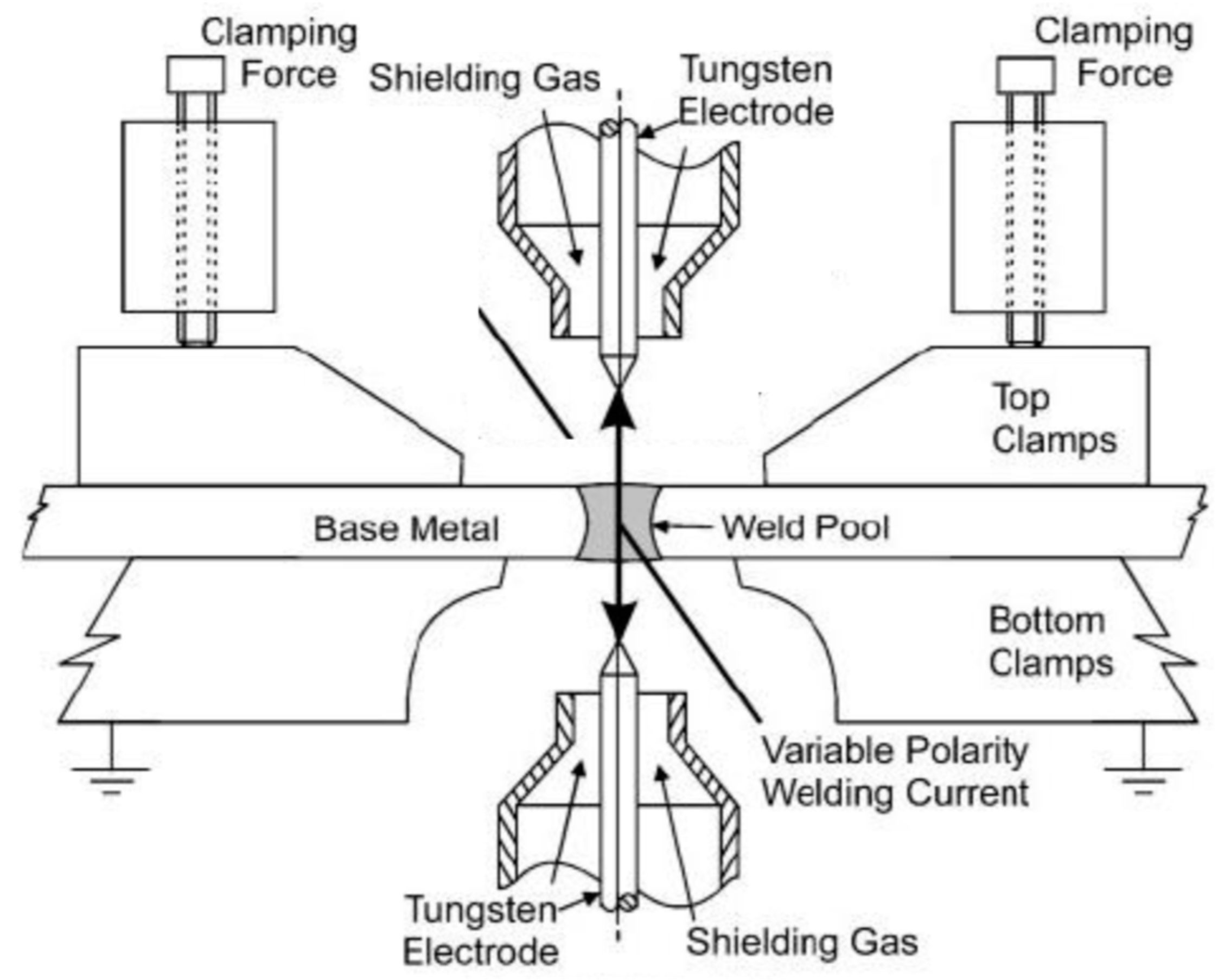
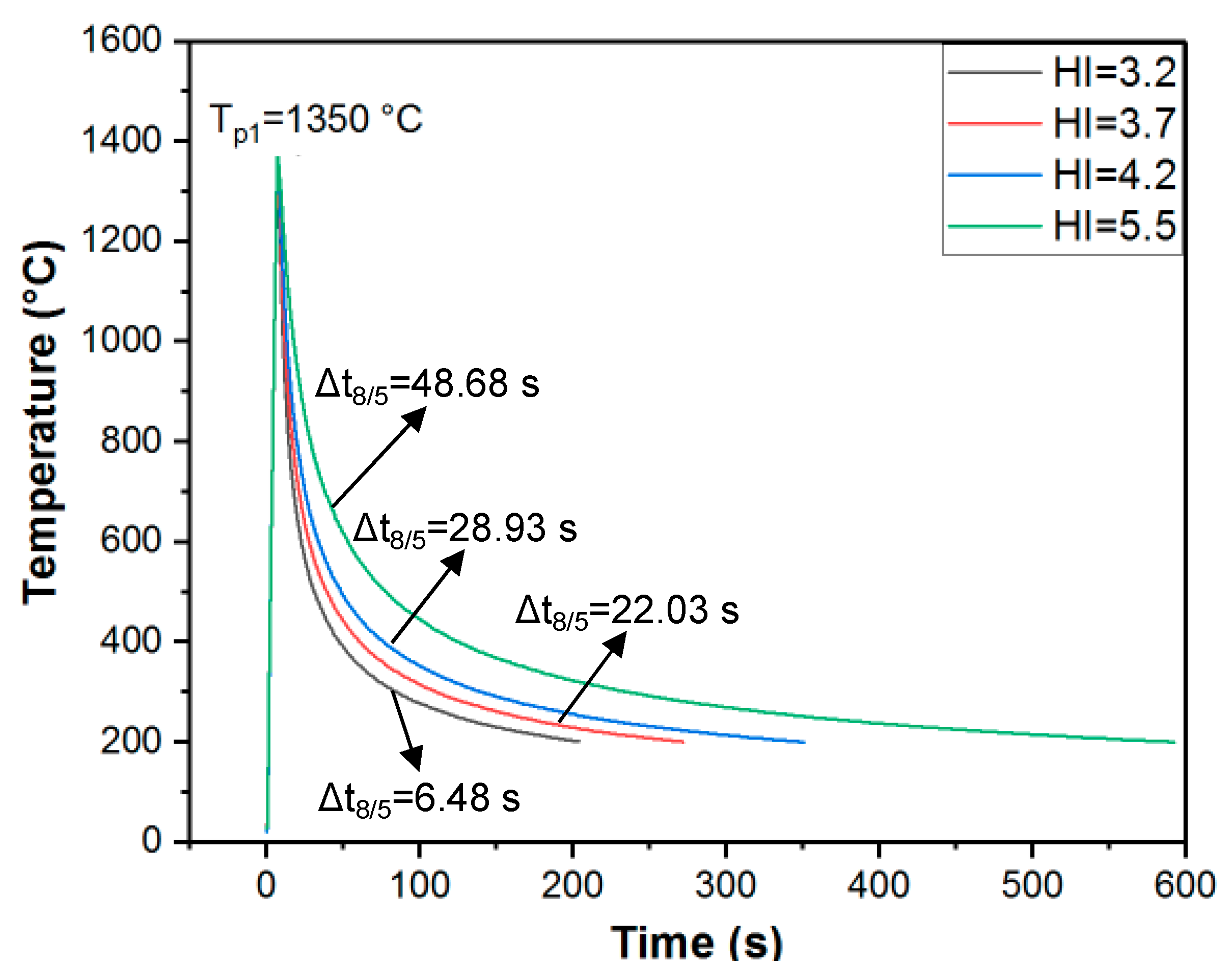
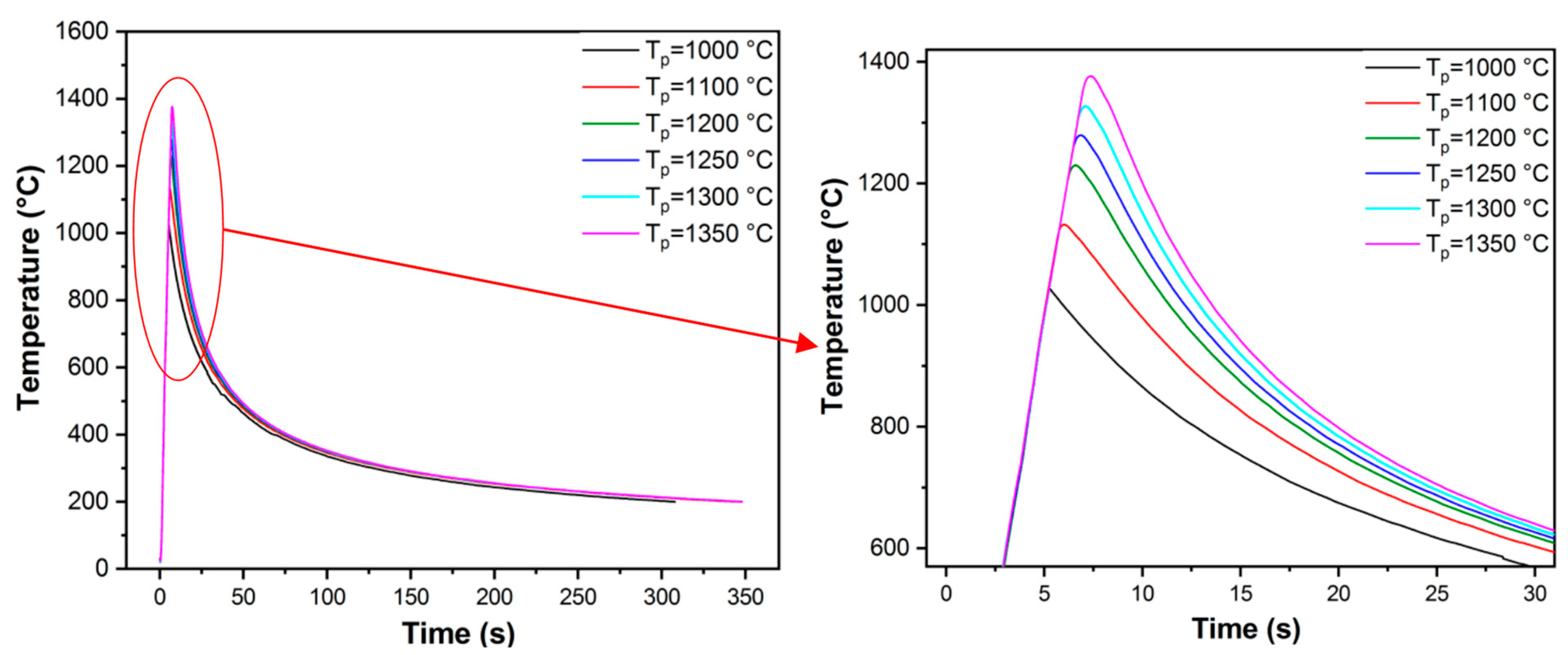
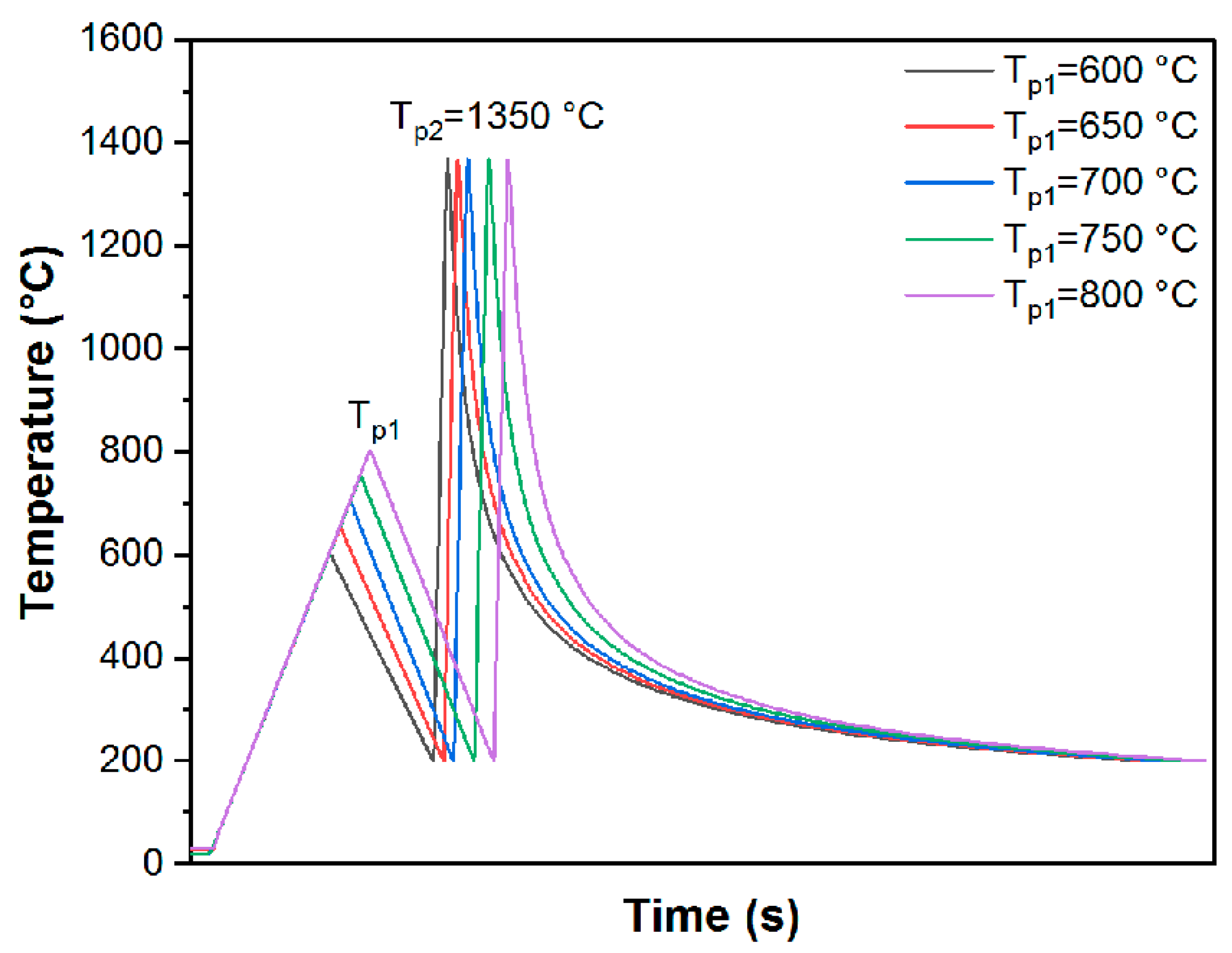
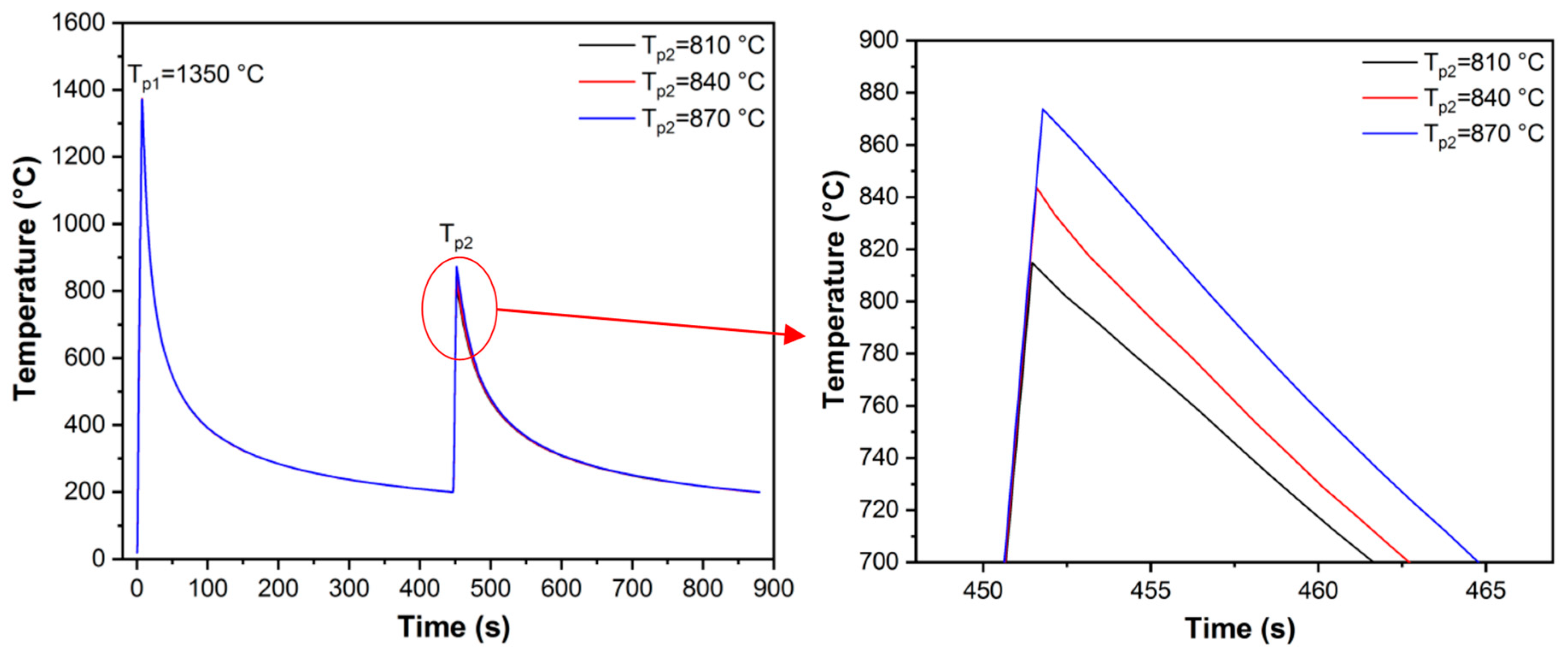
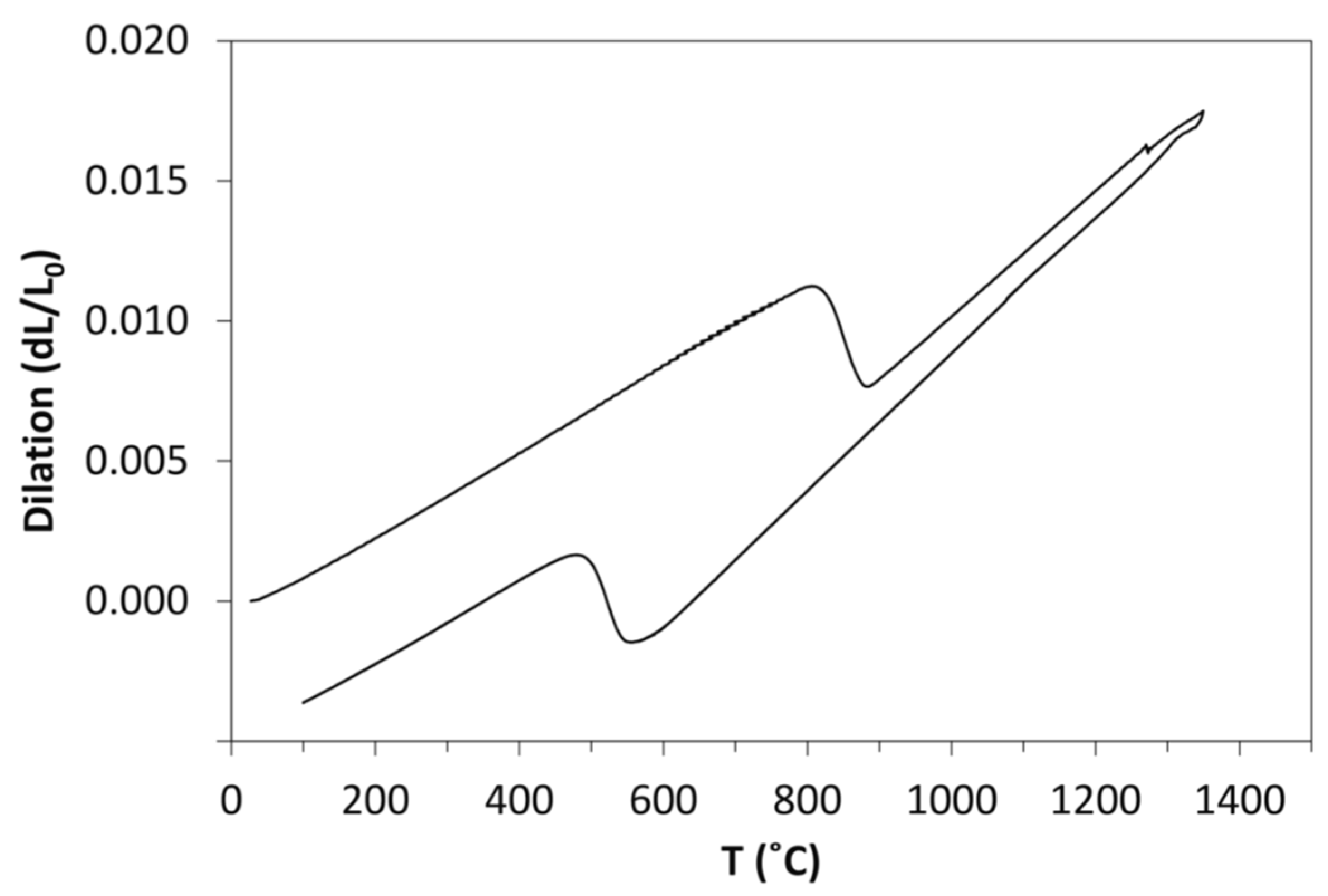
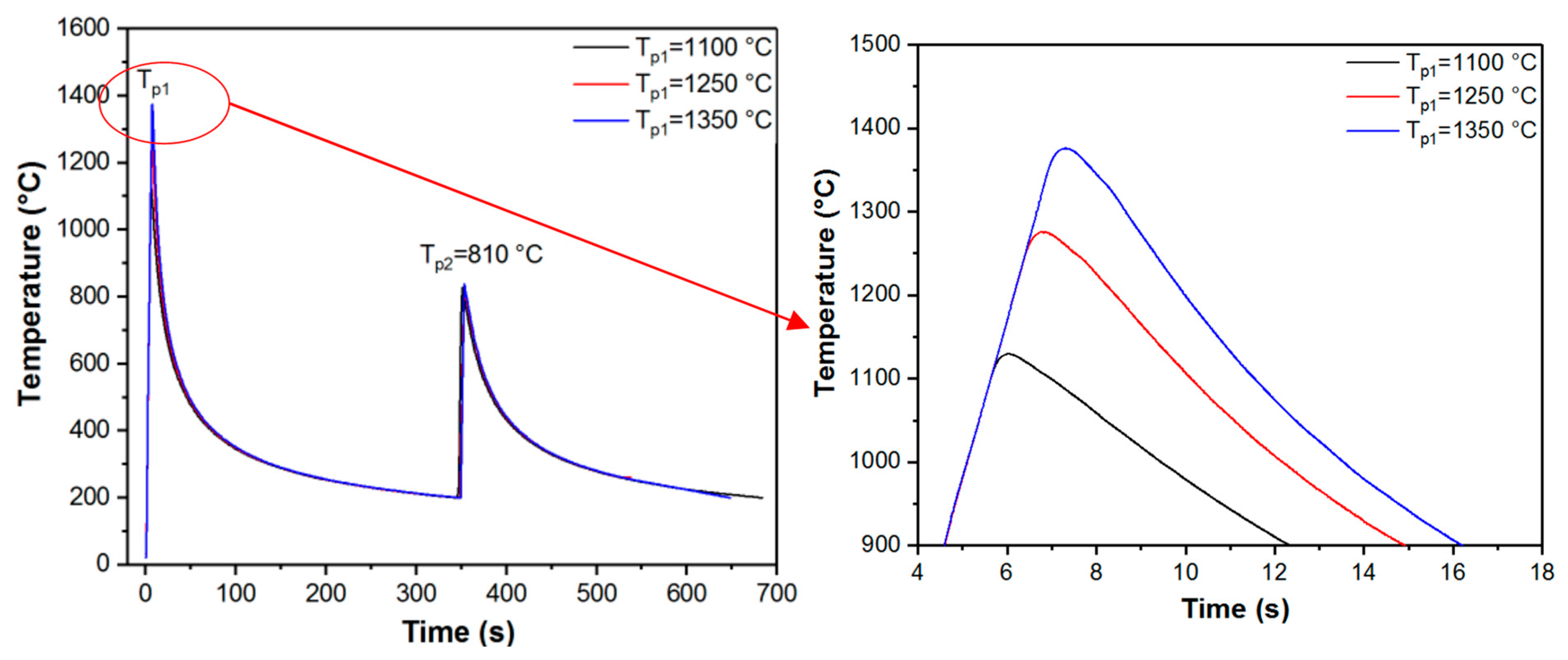

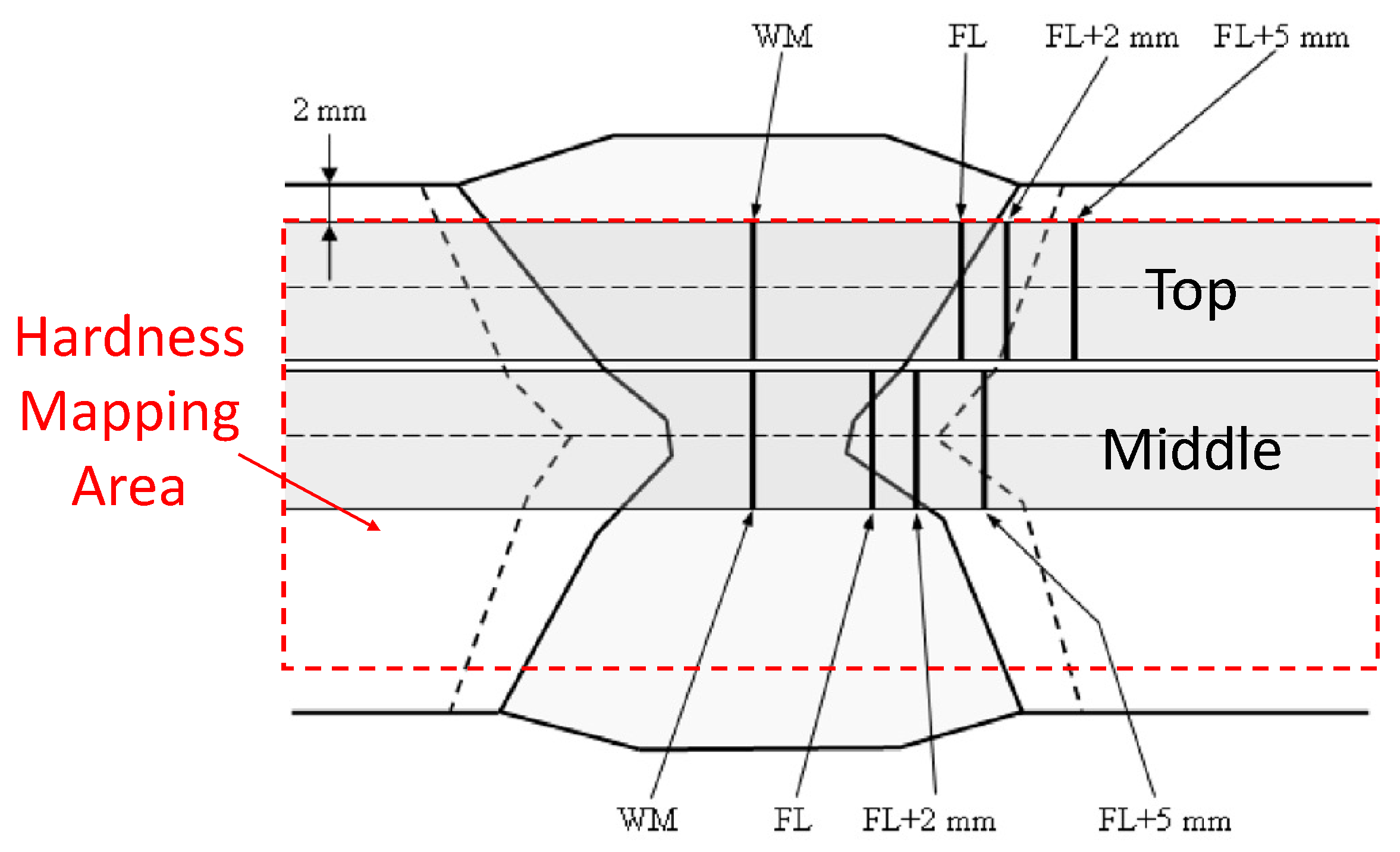
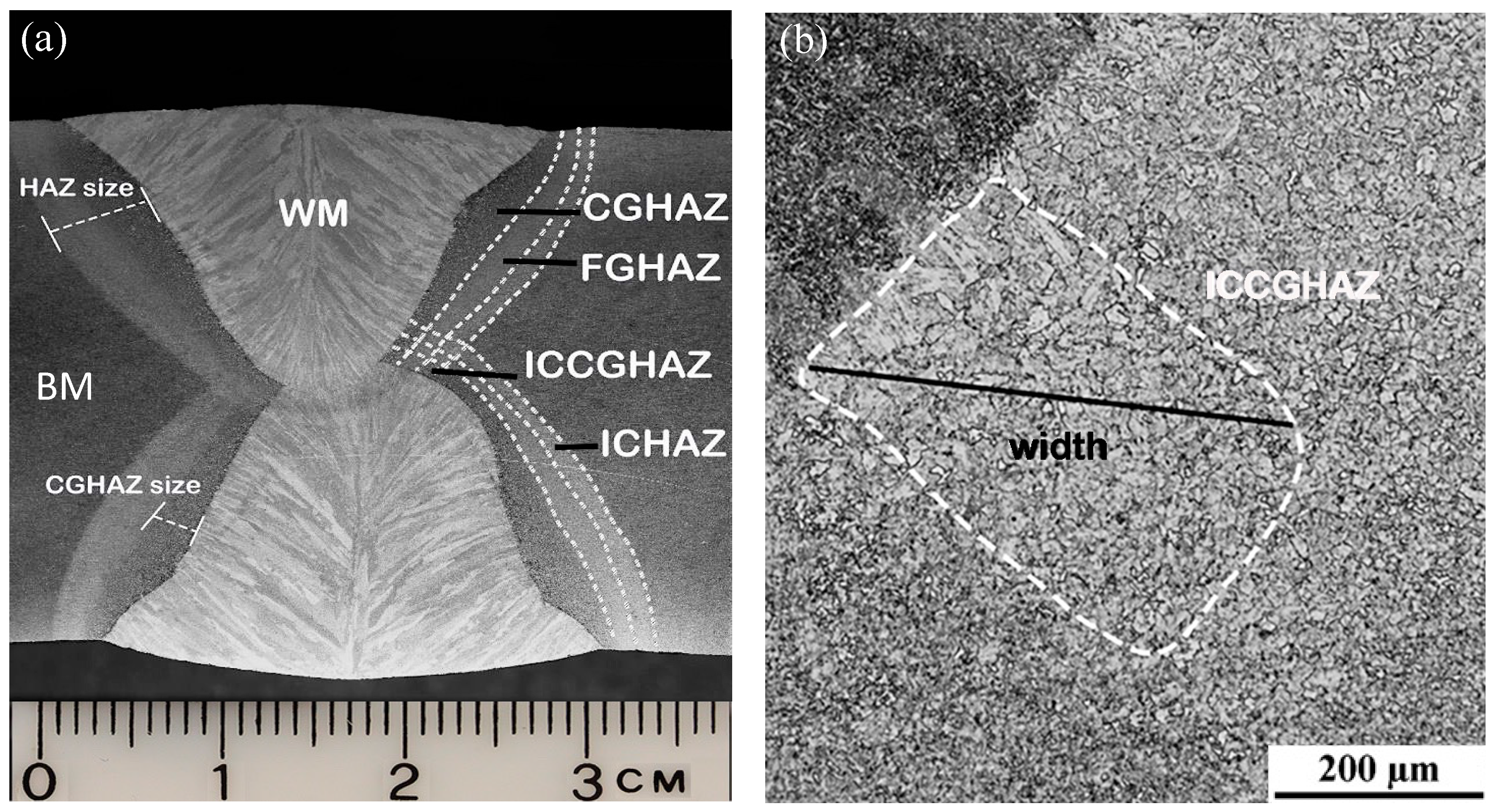

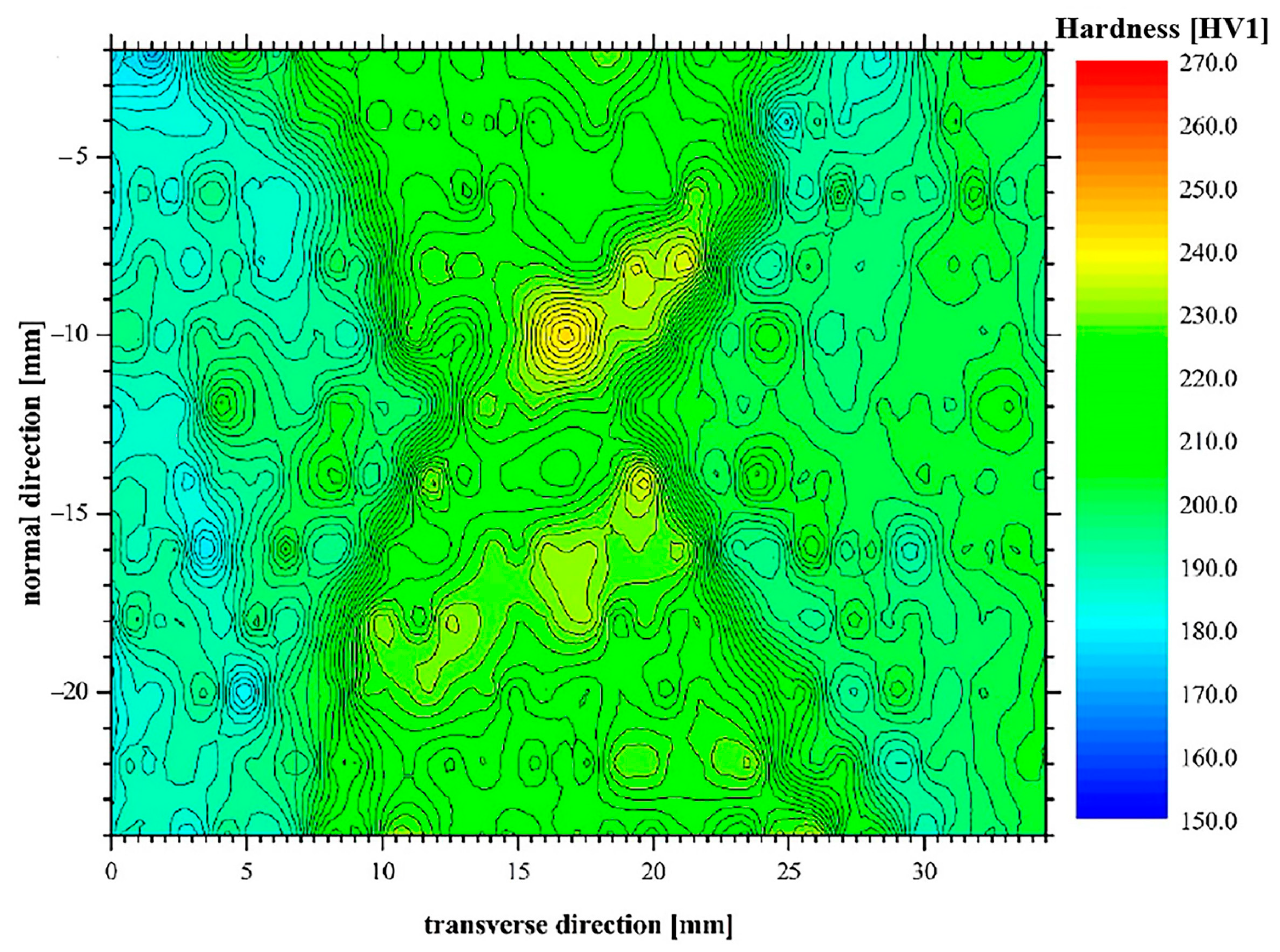
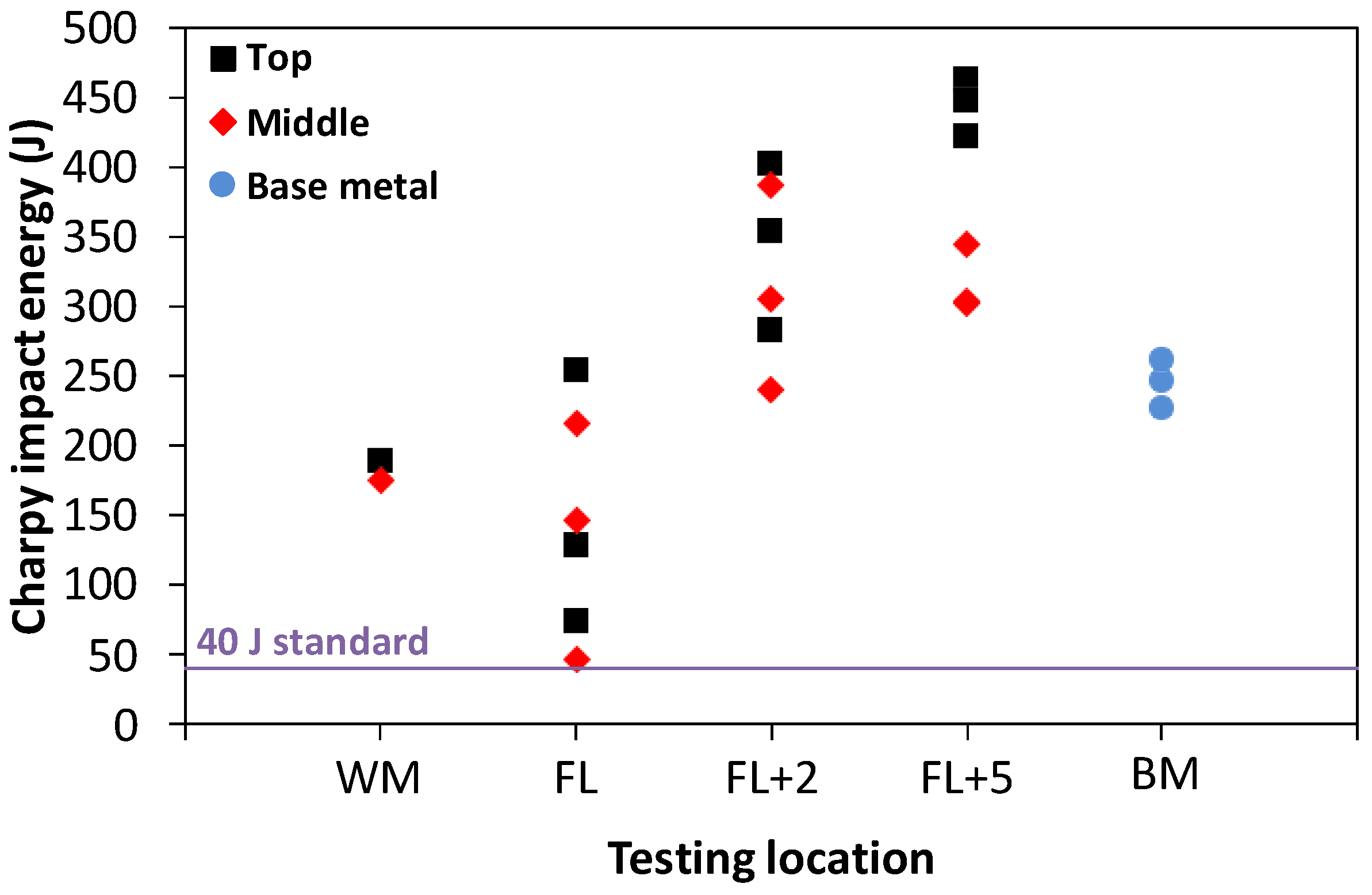

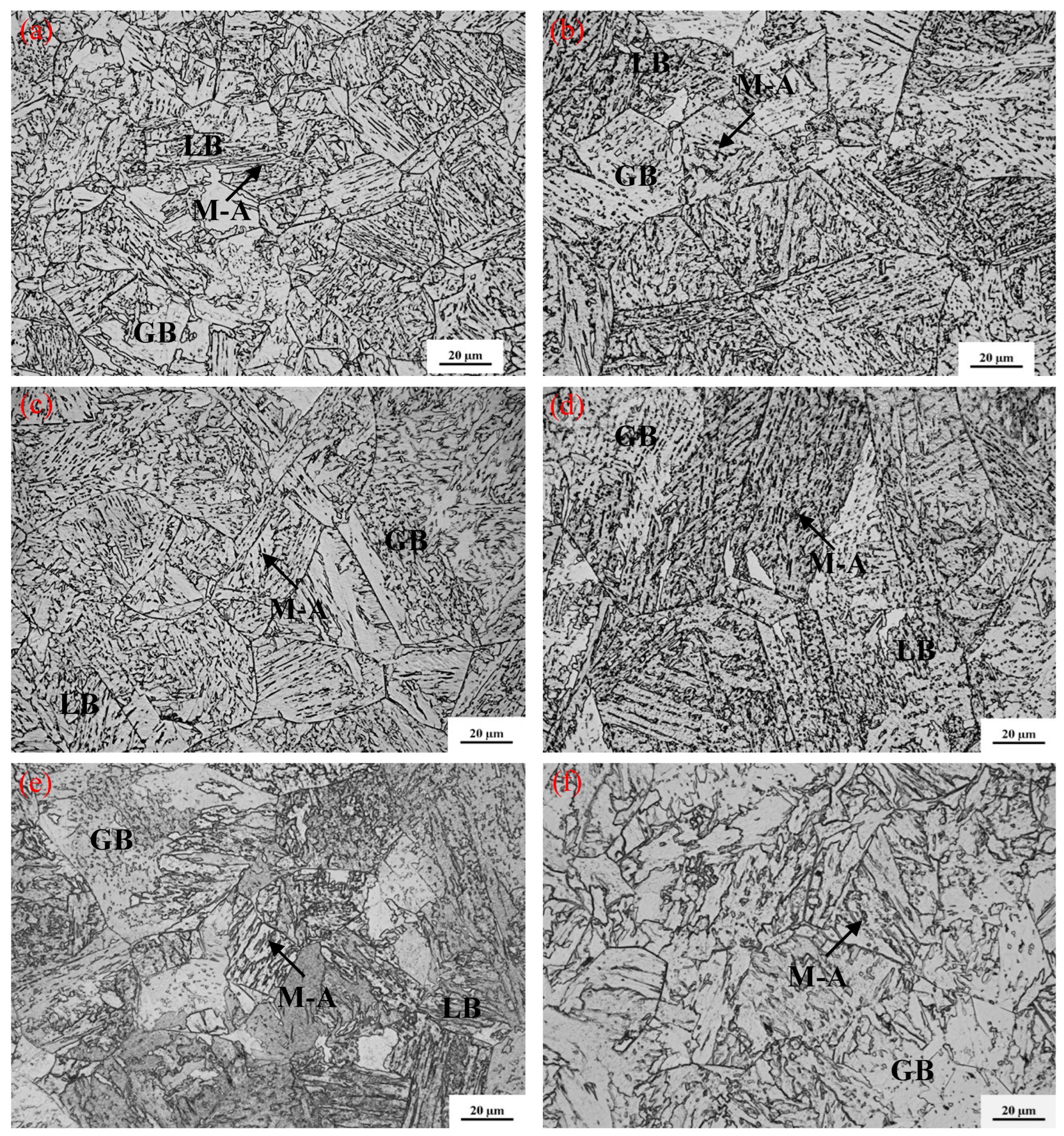
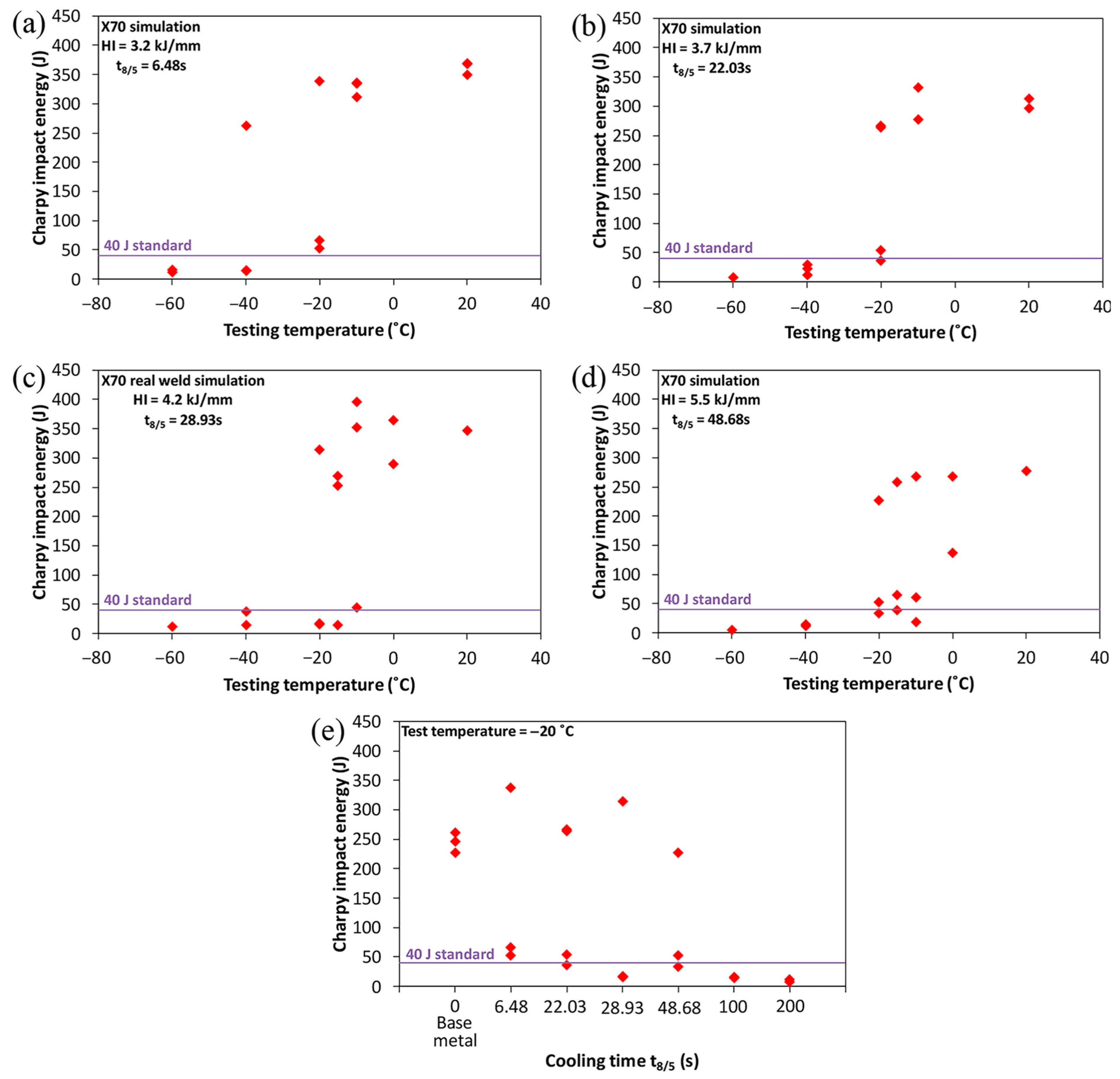
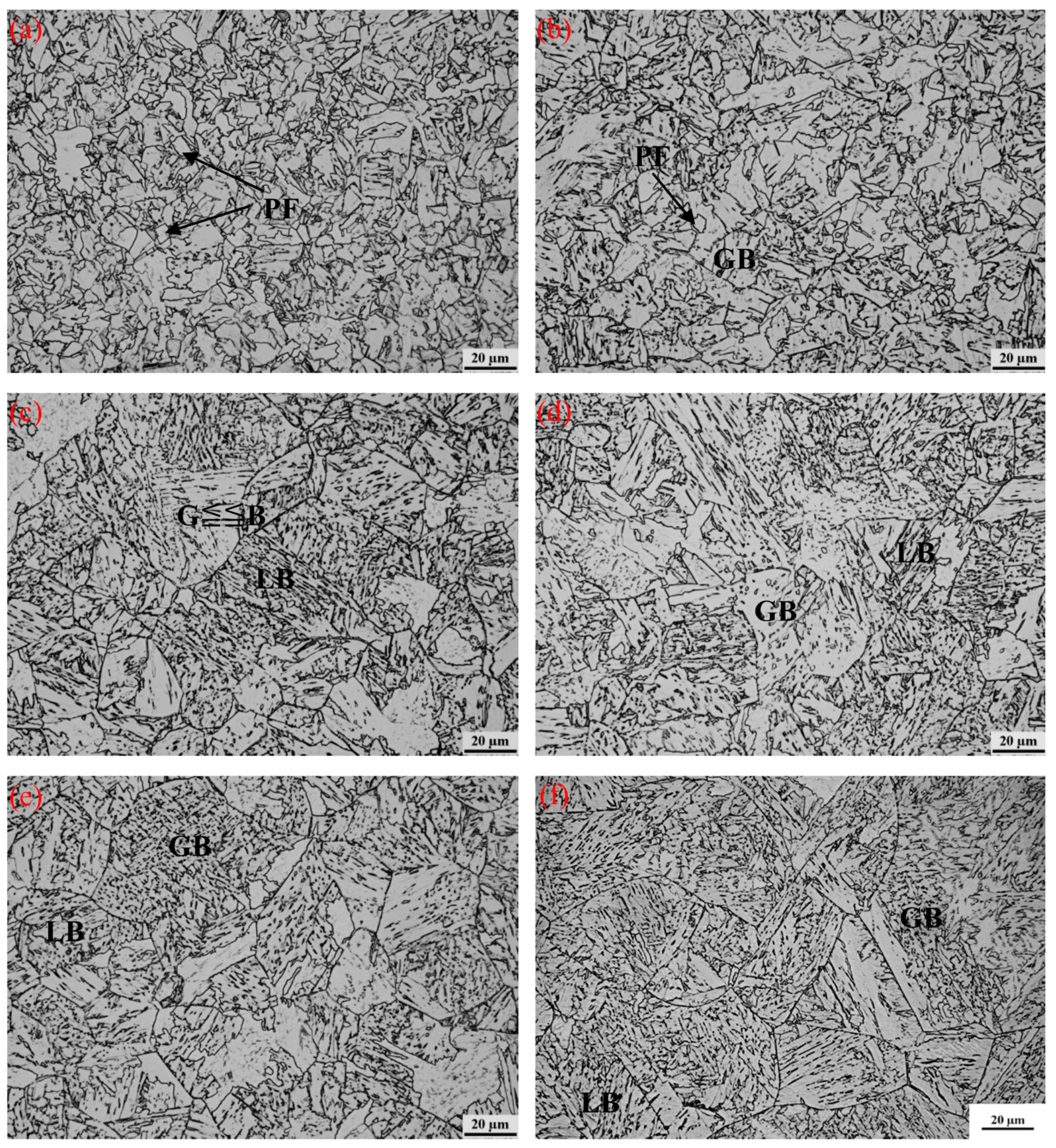
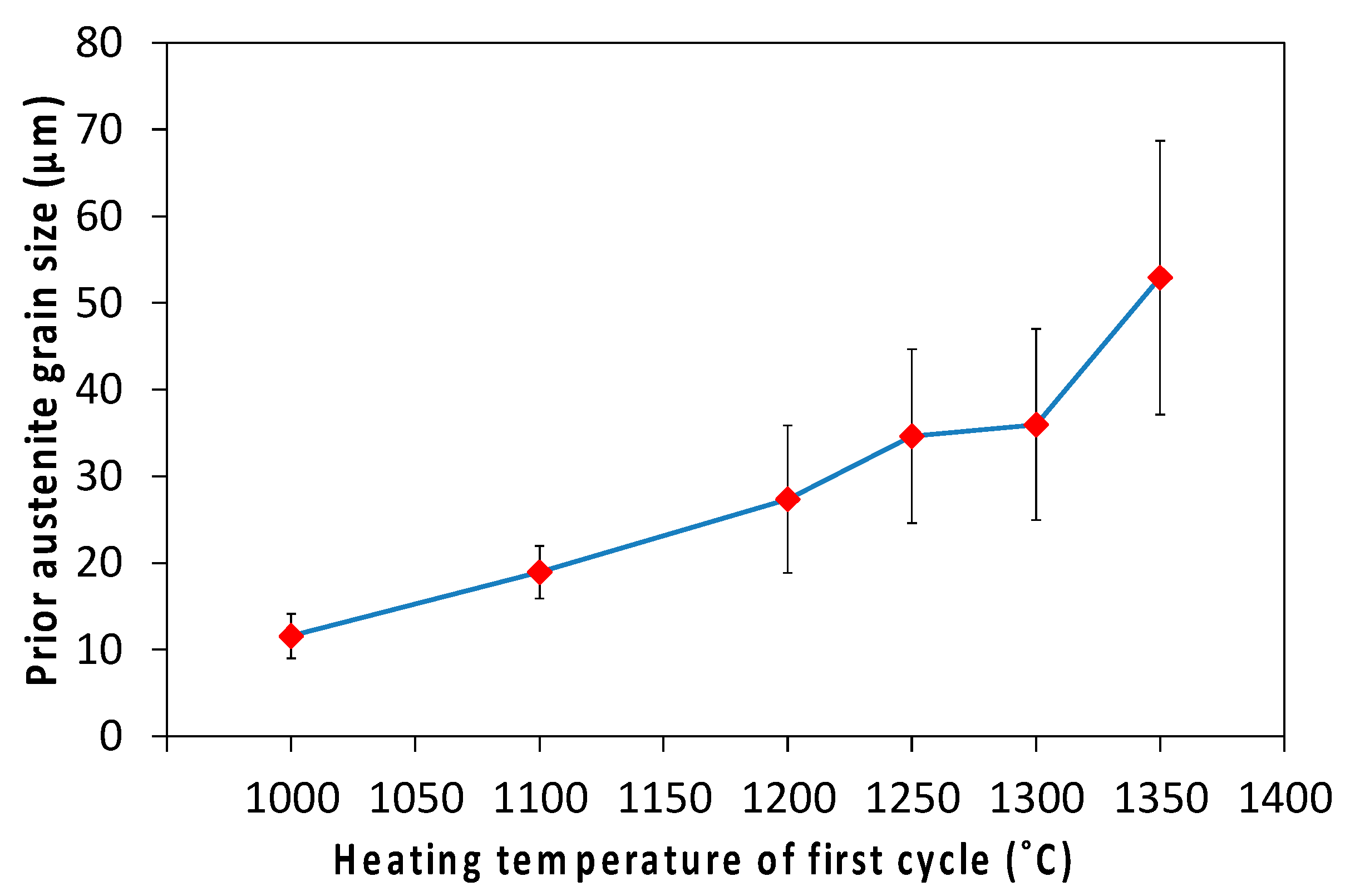
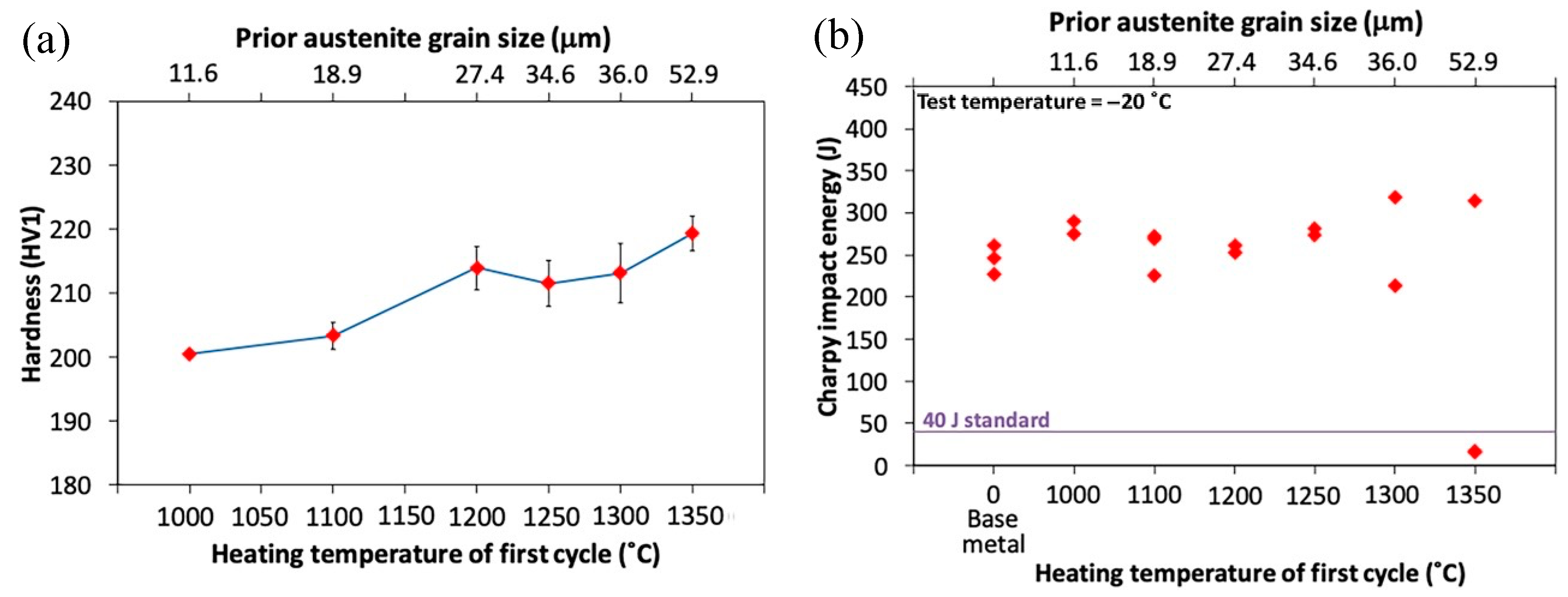
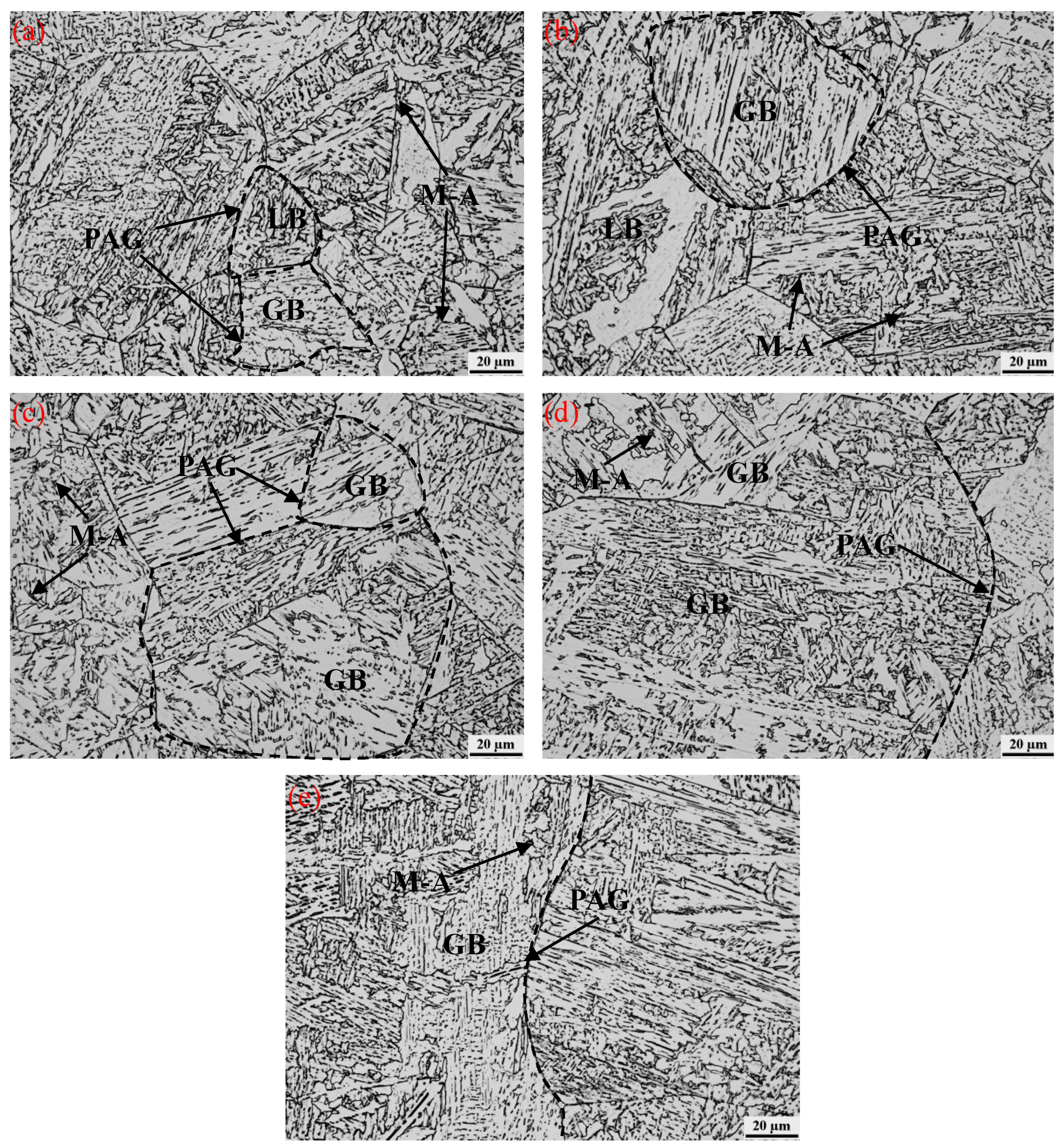
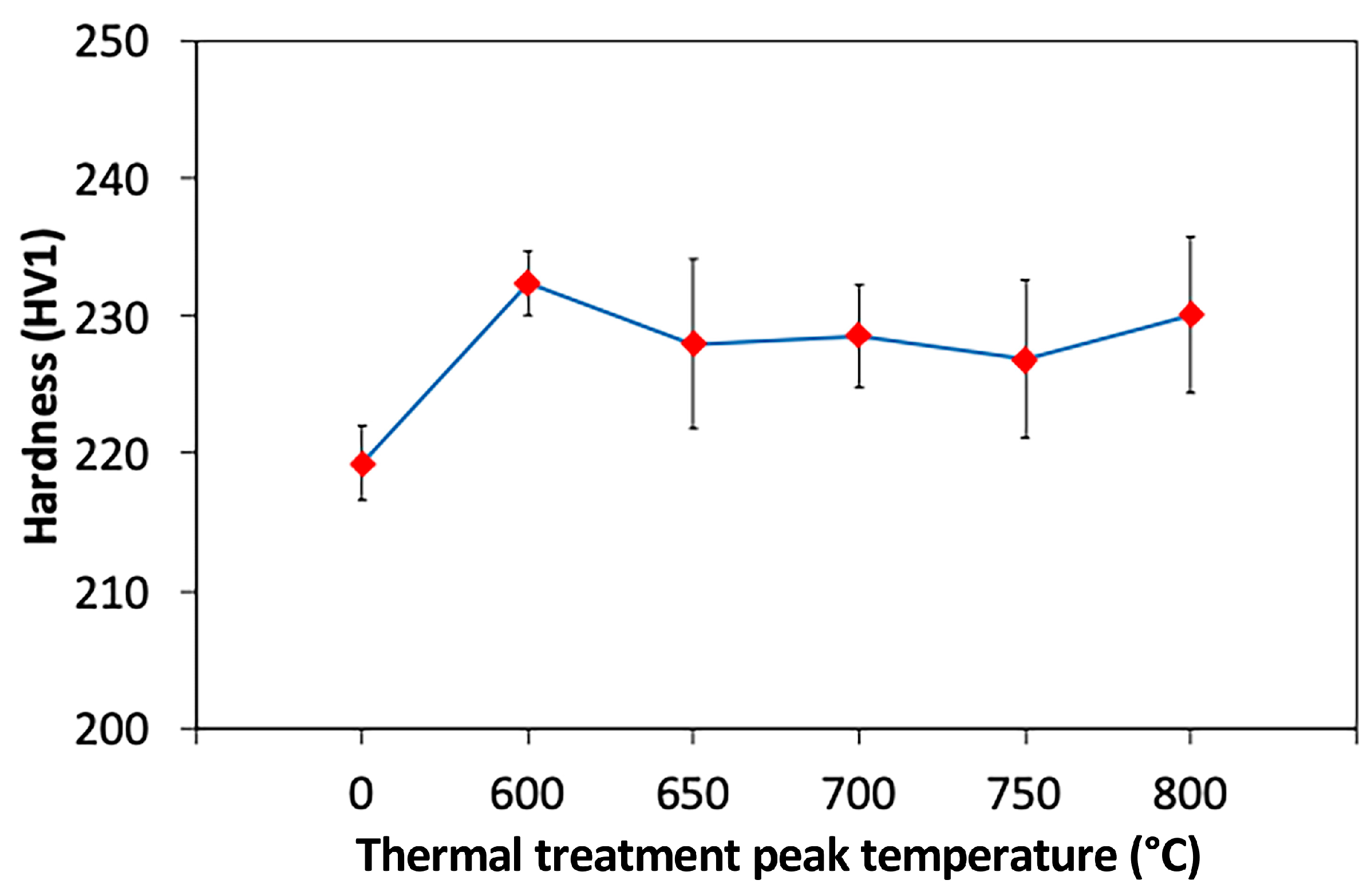



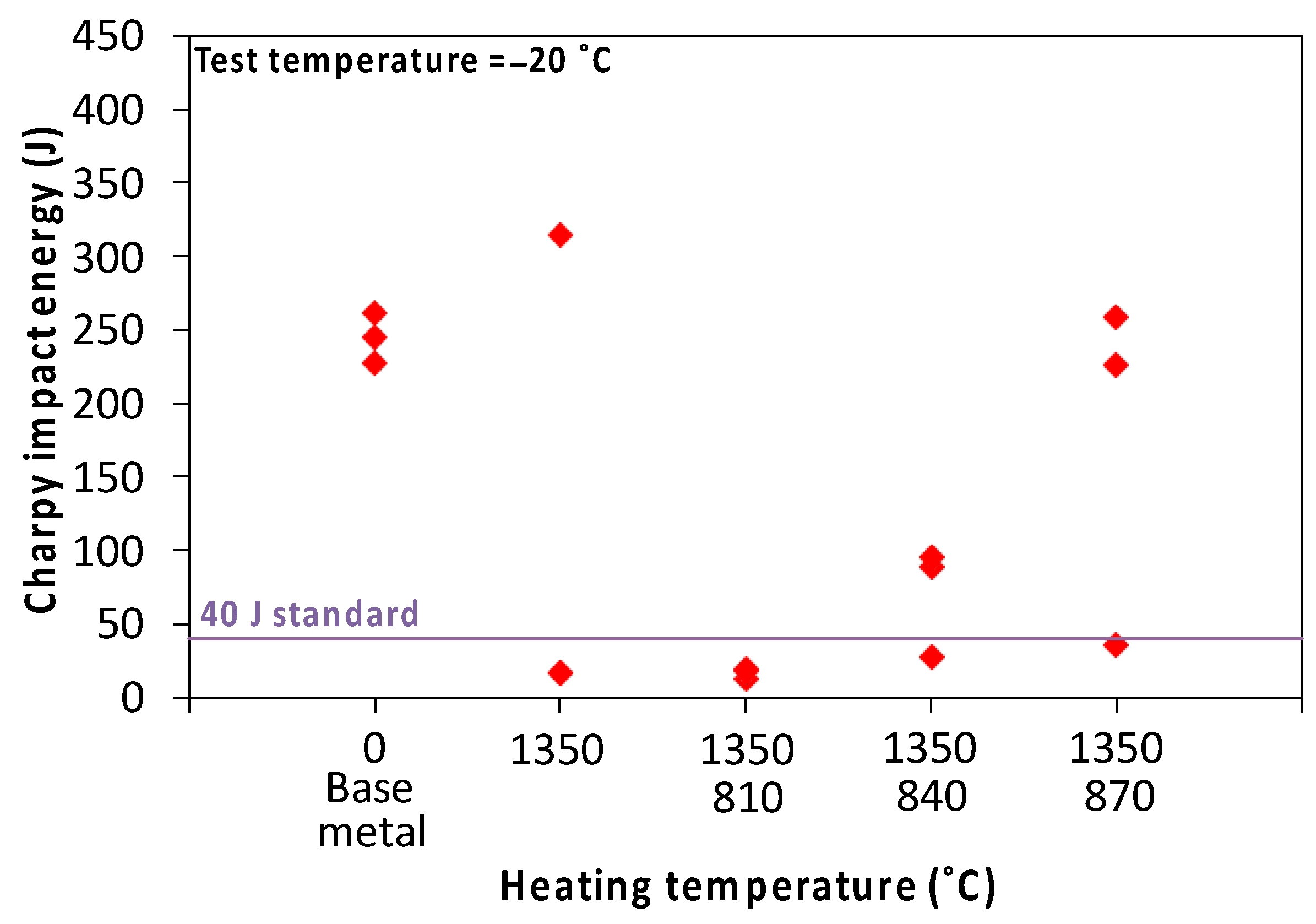
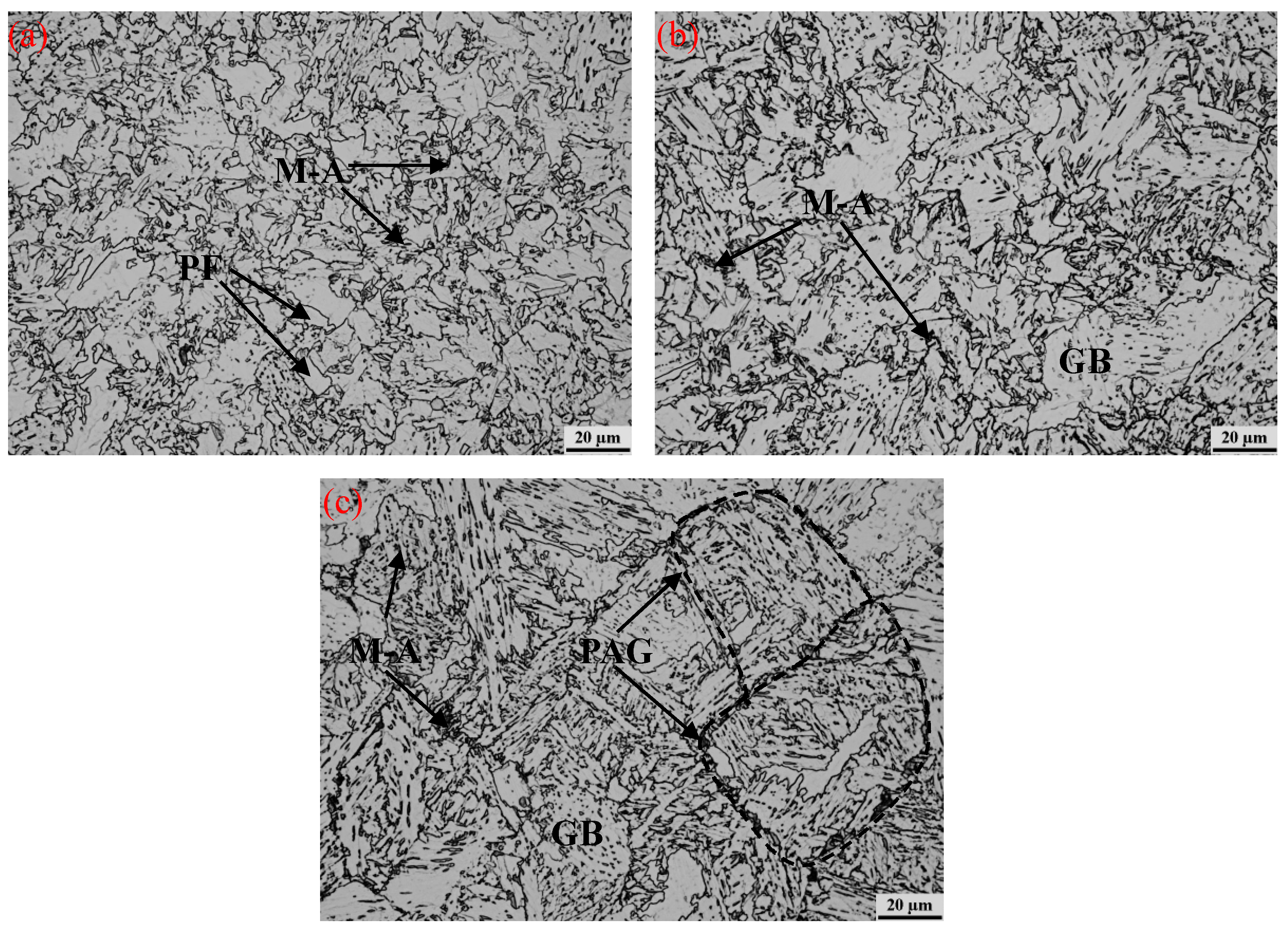
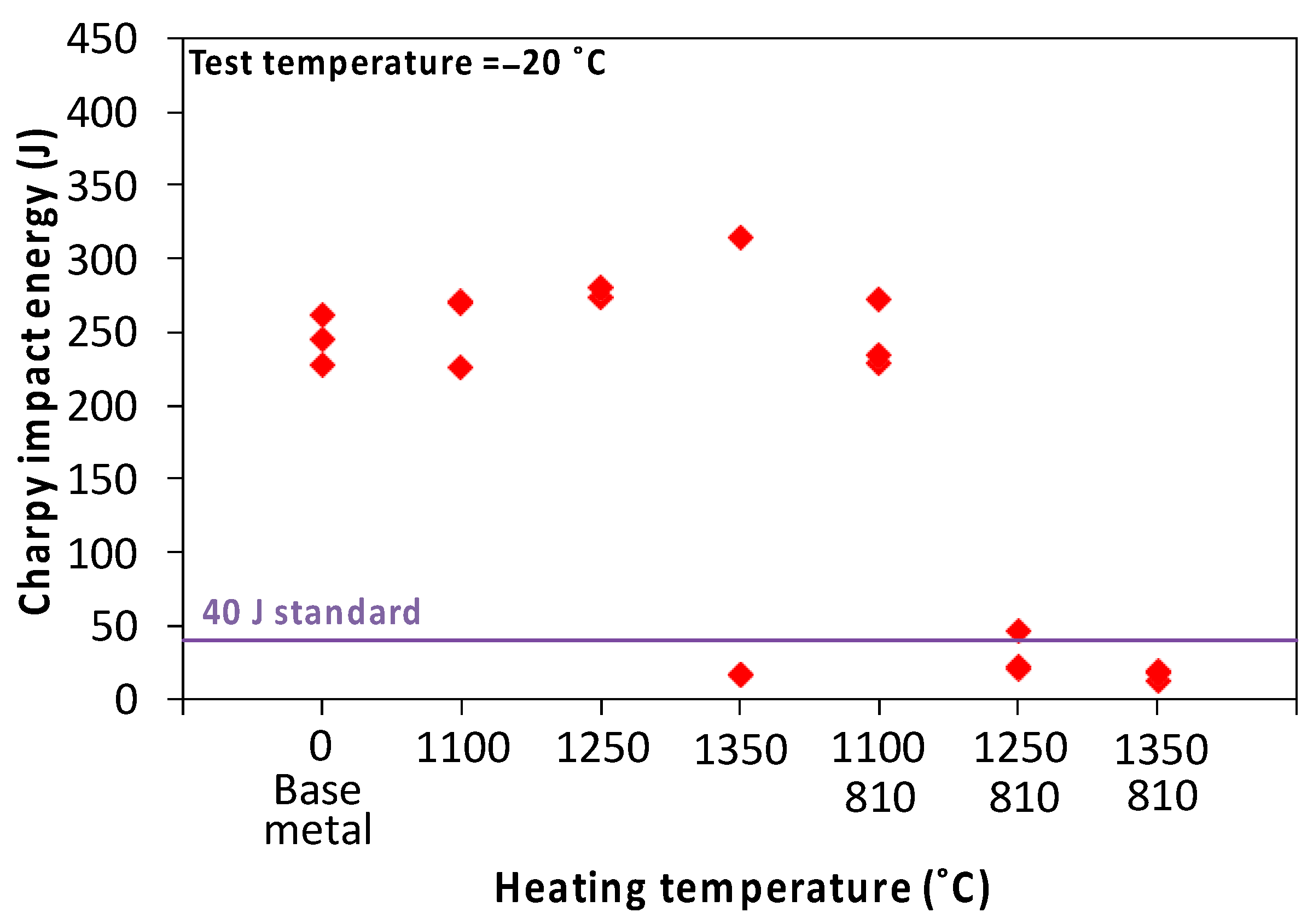
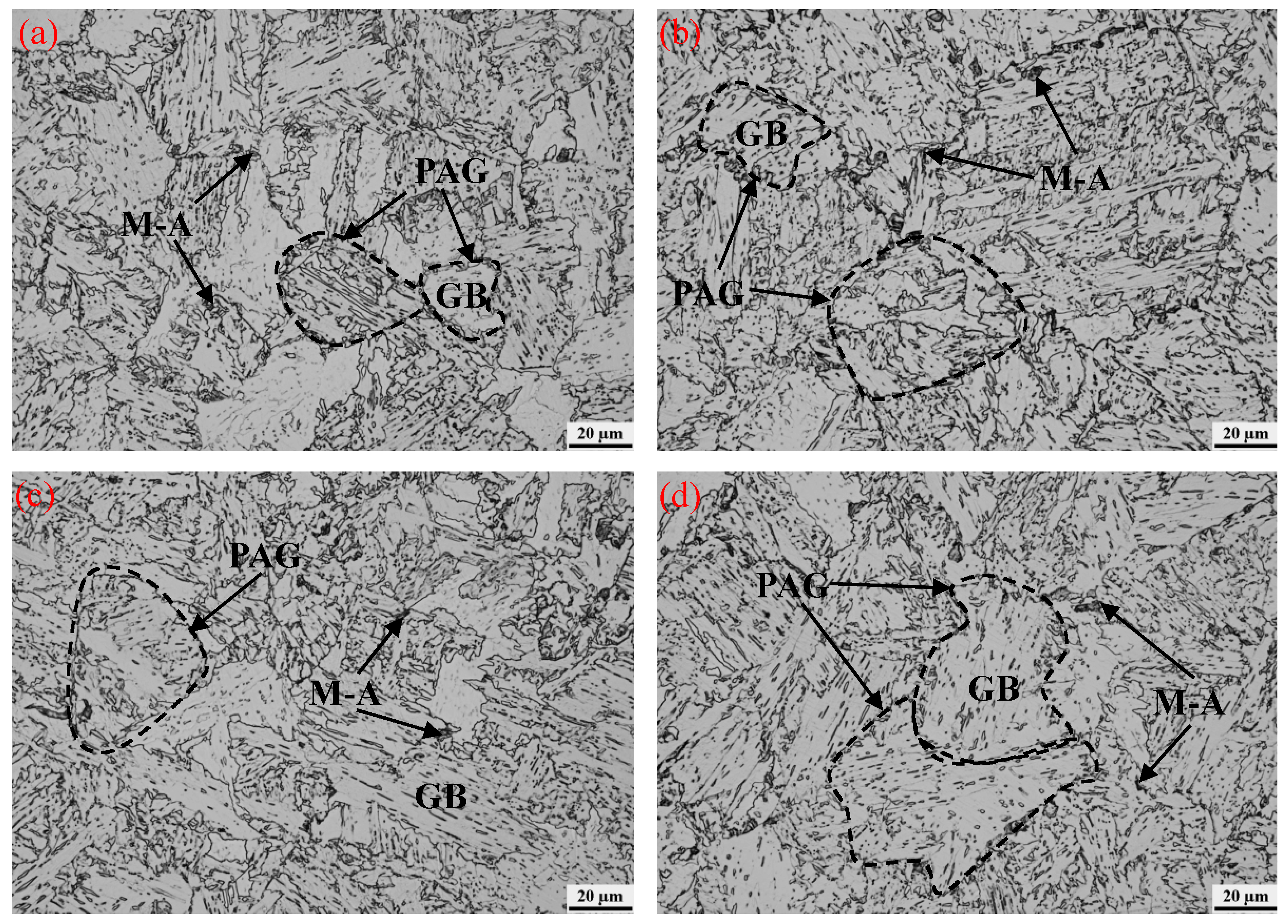
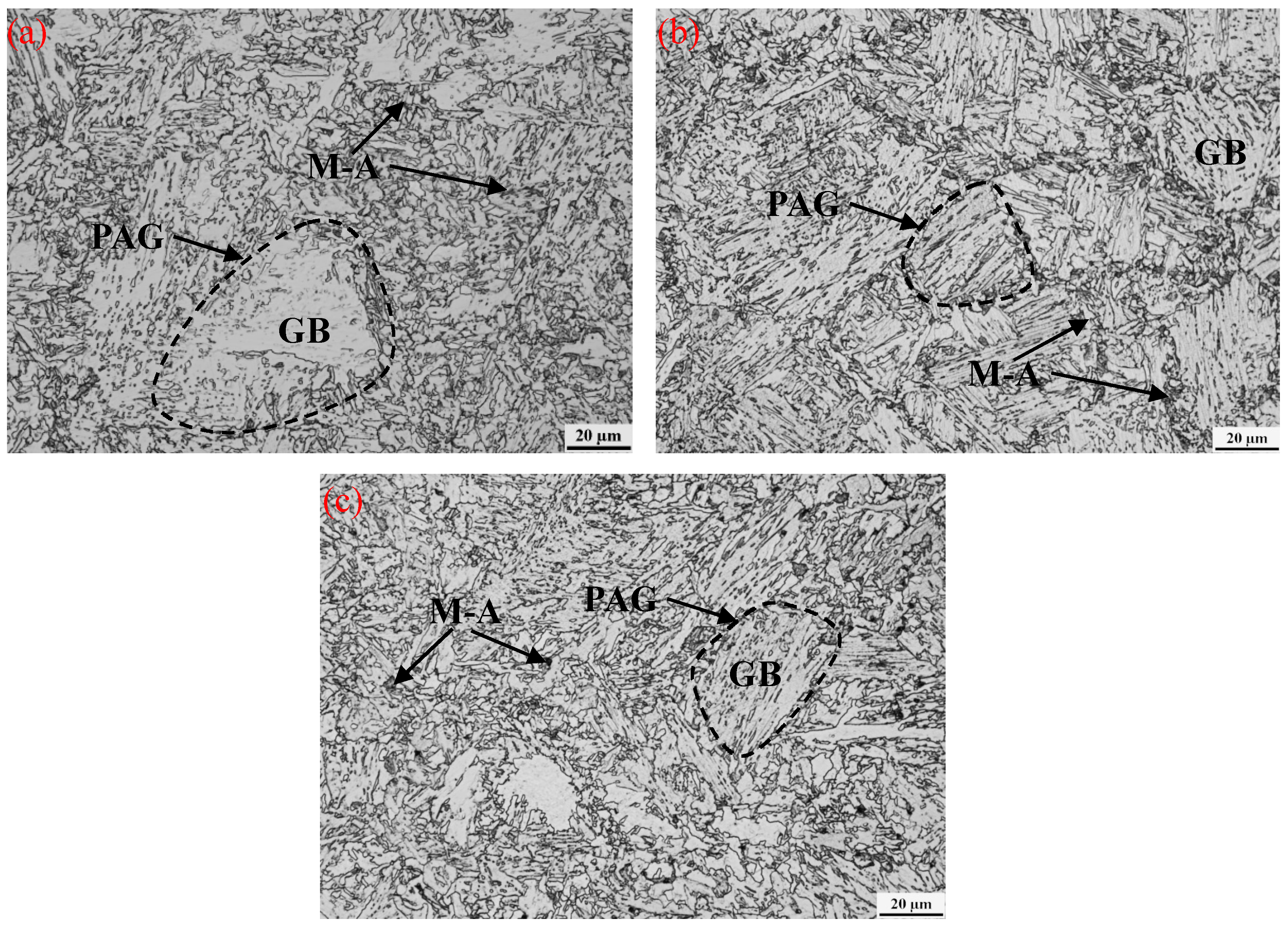

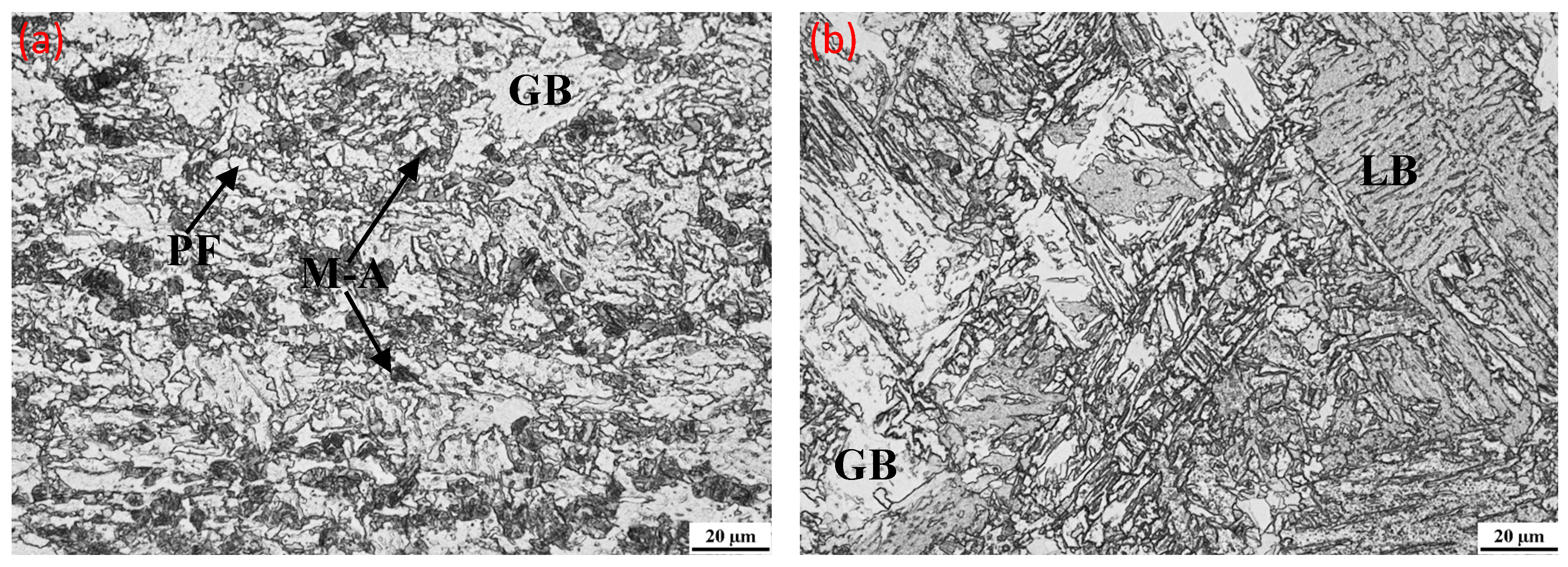

| C | Si | Mn | P | S | Cu | Ni | Cr | Mo | V | Nb | Al | Ti | N | Fe |
|---|---|---|---|---|---|---|---|---|---|---|---|---|---|---|
| 0.043 | 0.248 | 1.73 | 0.006 | 0.001 | 0.010 | 0.196 | 0.232 | 0.135 | 0.001 | 0.046 | 0.034 | 0.014 | 0.0030 | Bal. |
| Sample Position | Sample Direction | Yield Strength (MPa) | Tensile Strength (MPa) | Elongation (%) |
|---|---|---|---|---|
| Pipe | Transverse | 582 | 698 | 23 |
| Pipe | Longitudinal | 605 | 687 | 24 |
| Weld | Transverse (fractured at pipe body) | — | 663 | — |
| Weld | Longitudinal | 563 | 665 | 26 |
| Pass | Current (A) | Voltage (V) | Travel Speed (mm/min) | Heat Input (kJ/mm) | ||||||
|---|---|---|---|---|---|---|---|---|---|---|
| 1 (DC) | 2 (AC) | 3 (AC) | 4 (AC) | 1 | 2 | 3 | 4 | |||
| Inner SAW | 800–1000 | 675–825 | 630–770 | 540–660 | 30–34 | 32–36 | 34–38 | 36–40 | 1100–1400 | 4–6 |
| Outer SAW | 800–1000 | 540–660 | 520–640 | 500–600 | 28–32 | 30–34 | 32–36 | 33–37 | 1000–1300 | 4–6 |
| Material | Peak Temperature | Heating Rate | Holding Time | HI (Δt8/5) |
|---|---|---|---|---|
| X70 | 1350 °C | 200 °C/s | 0.5 s | 3.2 kJ/mm (6.48 s) 3.7 kJ/mm (22.03 s) 4.2 kJ/mm (28.93 s, actual weld HI) 5.5 kJ/mm (48.68 s) 78.83 kJ/mm (100 s) 111.48 kJ/mm (200 s) |
| Peak Temperature | Heating Rate | Holding Time | Cooling Time/Rate | |
|---|---|---|---|---|
| 1st pass | 1350 °C | 200 °C/s | 0.5 s | Δt8/5 = 28.93 s |
| 2nd pass | 810 °C | |||
| 3rd pass | 300 °C | 1 s | Quenching in Helium | |
| 400 °C | 1 s | Quenching in Helium | ||
| 500 °C | 1 s | Quenching in Helium | ||
| 1 s | Controlled cooling at 5 °C/s | |||
| 30 s | Quenching in Helium | |||
| 60 s | Quenching in Helium | |||
| 600 °C | 1 s | Quenching in Helium |
| Steel No. | Average Width of HAZ (mm) | Average Width of CGHAZ (mm) | Percentage of CGHAZ in HAZ | Average Width of ICCGHAZ (mm) | Percentage of ICCGHAZ in HAZ |
|---|---|---|---|---|---|
| #1 | 5.5 | 2.8 | 51.0% | 437 | 7.9% |
| Tp2, °C | 810 | 840 | 870 |
|---|---|---|---|
| Vf of M–A, vol.% | 4.7 ± 0.7 | 2.5 ± 0.4 | 2.2 ± 0.5 |
| Fraction of Grain Boundary M–A, vol.% | 2.9 ± 0.5 | 0 | 0 |
Disclaimer/Publisher’s Note: The statements, opinions and data contained in all publications are solely those of the individual author(s) and contributor(s) and not of MDPI and/or the editor(s). MDPI and/or the editor(s) disclaim responsibility for any injury to people or property resulting from any ideas, methods, instructions or products referred to in the content. |
© 2023 by the authors. Licensee MDPI, Basel, Switzerland. This article is an open access article distributed under the terms and conditions of the Creative Commons Attribution (CC BY) license (https://creativecommons.org/licenses/by/4.0/).
Share and Cite
Ma, Y.; Su, L.; Shen, C.; Fletcher, L.; Li, H.; Sun, L.; Zheng, L.; Zhang, C. Improving the Weld Heat-Affected-Zone (HAZ) Toughness of High-Strength Thick-Walled Line Pipes. Metals 2023, 13, 2018. https://doi.org/10.3390/met13122018
Ma Y, Su L, Shen C, Fletcher L, Li H, Sun L, Zheng L, Zhang C. Improving the Weld Heat-Affected-Zone (HAZ) Toughness of High-Strength Thick-Walled Line Pipes. Metals. 2023; 13(12):2018. https://doi.org/10.3390/met13122018
Chicago/Turabian StyleMa, Yan, Lihong Su, Chen Shen, Leigh Fletcher, Huijun Li, Leilei Sun, Lei Zheng, and Chuanguo Zhang. 2023. "Improving the Weld Heat-Affected-Zone (HAZ) Toughness of High-Strength Thick-Walled Line Pipes" Metals 13, no. 12: 2018. https://doi.org/10.3390/met13122018
APA StyleMa, Y., Su, L., Shen, C., Fletcher, L., Li, H., Sun, L., Zheng, L., & Zhang, C. (2023). Improving the Weld Heat-Affected-Zone (HAZ) Toughness of High-Strength Thick-Walled Line Pipes. Metals, 13(12), 2018. https://doi.org/10.3390/met13122018








